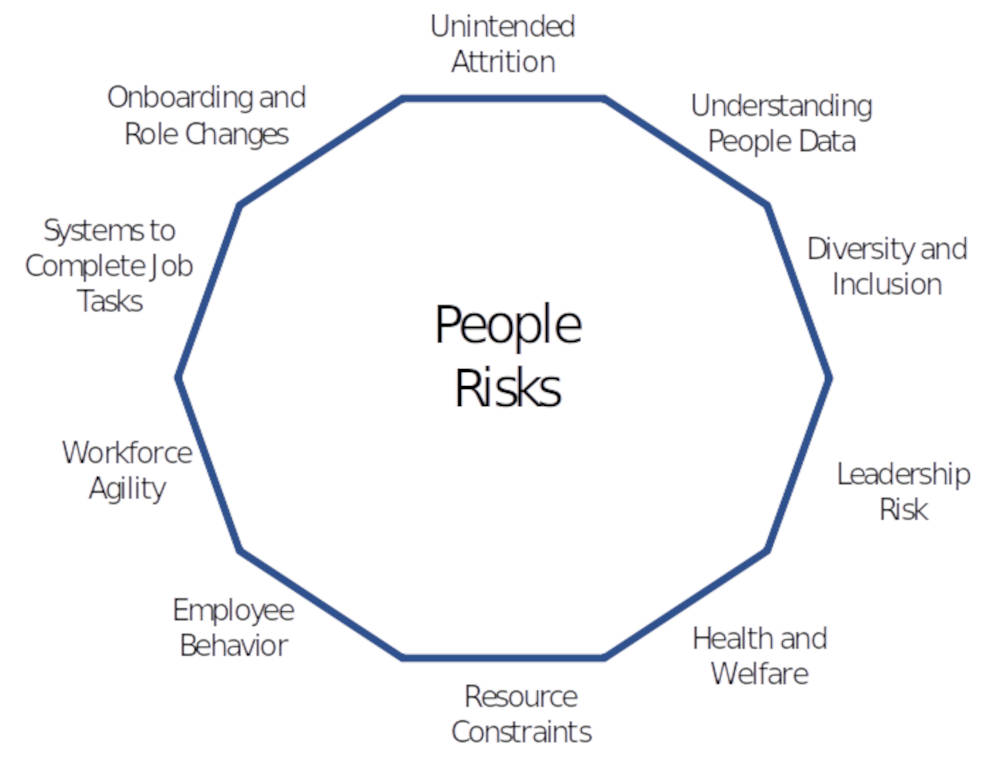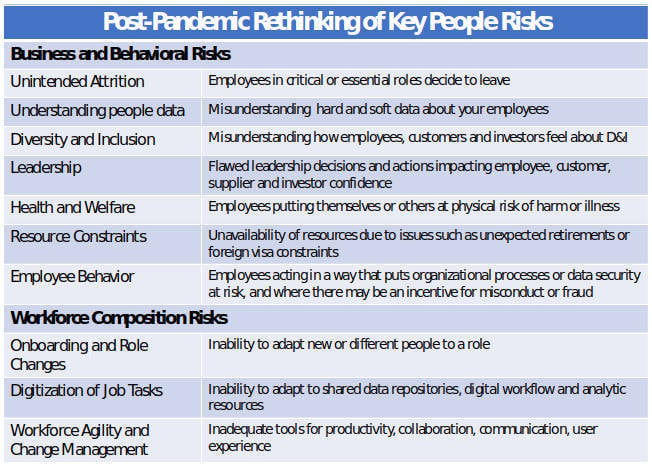CRO Outlook
Friday, August 21, 2020
By Brenda Boultwood
COVID-19 has forced businesses to rethink the way they treat and manage employees. Considering the work-from-home strategies adopted by many firms and the general economic decline, there is now an unprecedented level of people risks. Consequently, firms need to think about alternative approaches that may give them an employee management leg-up on competitors - particularly in the aftermath of the pandemic.
Clear-headed answers are out there. And it is okay to say, “we don't know,” while we take more time to find the answers. It's not okay to mute the voices from below and outside.

Many organizations are learning that strong leadership, evolving technology practices and communication tools can improve team productivity and engagement in the post-COVID era.
Mandatory work-from-home measures have accelerated changes in the way people and projects are managed, often with superior results. But this approach has also created obstacles, and the challenge for every organization that must support a hybrid remote and in-person staff is not only to ensure personal safety but also to find ways to keep employees engaged and productive.

When developing a post-pandemic people risk framework, a firm must consider two distinct risk categories. Business and behavioral risks describe how employees can change results. Workforce composition risks, on the other hand, occur when employees do not have the skills and tools to do their jobs in an engaging manner.

Business and Behavioral Risks
Let's now take a closer look at the dangers that fall under the “business and behavioral risks” category:
Unintended Attrition
Essential workers and high performers are vital to every organization. But good people find better opportunities when they lose trust in leadership or organizational purpose.
Misunderstanding People Data
Beyond the standard people data stored in an HR system, which is often designed to meet compliance and reporting requirements, employee questions and incident reports must be internally crowdsourced constantly. During uncertain times and from remote locations, information is less likely to be offered up, but issues and problems still must be ferreted out.
Tools for crowdsourcing issues, concerns and complaints help us identify emerging risks. Once the risk is identified, the tools - with the right set of questions - reveal the best mitigation steps.
Post-pandemic internal crowdsourcing topics may include organizational purpose, systemic racism, the trade-off between resilience and profitability, civil unrest, working from home and employee security.
Diversity and Inclusion
Today, employees are reading a lot about systemic racism, and it's therefore very important to be aware of, and feel proud of, the progressive steps a company is taking to address this issue. A lack of communication about this topic can create an echo chamber of beliefs.
Leadership
Leaders need to make and communicate basic decisions about the future of their workforce.
For example, Twitter and Square have announced permanent work-from-home strategies - but many other companies have remained silent, leaving employees to guess when deciding on, say, whether to sign a new apartment lease or renew a gym membership.
Do your company's leaders communicate with the right balance of optimism and realism? This can be achieved through, e.g., one-on-one meetings, crowdsourced responses to pulse surveys and regular Zooming where you are present, authentic and empathetic.
To receive important feedback about how a company could change for the better, a leader must first ask the hard questions about systemic racism, geopolitics and misinformation campaigns.
Health and Welfare
OSHA safety rules and CDC COVID-19 guidelines offer an outline for a safe return to the workplace. Post-pandemic, given the lack of trust in public officials, executives will also have to ask employees what makes them feel safe.
Resource Constraints
External and internal factors - such as H1B1 visa constraints, ineffective training and unexpected retirements - must be considered in a post-pandemic world.
Employee Behaviors
Managers need to exercise professional skepticism in an era where business processes are being altered to accommodate new work arrangements, digitization and customer exigencies.
Workforce Composition Risks
Threats to staff make-up must also be considered when building a post-pandemic people risk framework. What do these entail? Here's a quick breakdown:
Inadequate On-Boarding and Role Change Training
If incumbent employees are asked to take on too much, they may feel overburdened. To build a pipeline of future talent, adequate resources must be in place for on-boarding and training.
Digitization of Job Tasks
Automation is on the rise, and employees must understand and accept technological changes in data management, workflow and reporting.
Meetings and Communications
Developing the right communication rhythm is dependent on the specific team and project - but, typically, meetings should be more frequent and more deliberate, with regular well-defined deliverables. Leaders must not only emphasize hitting milestones but also engage and motivate team members.
Best practices include effective use of collaboration tools (e.g., Slack, Teams); group video communication (e.g., Zoom, GoToMeetings, GoogleMeet); and informal and personal communication (quick calls, texts, etc.). Experience management software, moreover, can be used to better understand user and customer experiences.
Project Execution
Project managers (PMs) must be enabled and properly rewarded for successful projects. The use of a single ticketing system - through which PMs and agile leaders can monitor software backlog planning, release planning and overall progress - is essential.
It is equally important to ensure systematic management of data related to communication and to software development enhancements. Through cloud mobile apps, you can assign tasks to specific users, capture project requirements and manage several calendars simultaneously.
Agility and Change Readiness
Every firm must measure how positively and predictably employees and leaders react to change. Engagement means strong team dynamics, collaboration and morale. But long days of video conferencing and no interpersonal contact can be intense and exhausting.
Without the non-verbal language present at in-person meetings, people must hone listening skills and “read between the lines” in verbal communication. Leaders should also consider nominating a weekly “no-meetings” day while building breaks and reminders into the calendar. To help mimic the in-office routine, another idea is to start the first meeting of the day with a 15-minute “catch-up over coffee.”
Even with all of these steps, though, some team members will still yearn to get back to the office. It may be difficult, for example, for people with competing demands at home to be effective without a dedicated workspace.
Rather than a large corporate headquarters building, an organization with sufficient employee density in certain regions may also want to establish micro-offices.
Lastly, remember that new team members may not be able to meet face-to-face with their project team for some time. Workflow tools and methods will be needed to ensure new employees feel welcome, know their roles, understand the team dynamic and are comfortable asking questions.
Parting Thoughts
This people risk framework must be adapted for each organization. Continuous bottoms-up risk assessment is at the heart of understanding people - including employees, customers, investors and suppliers - better.
People practices learned through the pandemic will have lasting positive effects on our ability to evolve and execute strategy, even in the most difficult times.
Brenda Boultwood is an independent risk management consultant. She is the former senior vice president and chief risk officer at Constellation Energy, and has served as a board member at both the Committee of Chief Risk Officers (CCRO) and GARP. Previously, she was a senior vice president of industry solutions at MetricStream, where she was responsible for a portfolio of key industry verticals, including energy and utilities, federal agencies, strategic banking and financial services. Before that, she worked in a number of risk management, business roles and as the global head of strategy, Alternative Investment Services, at JPMorgan Chase, where she developed the strategy for the company's hedge fund services, private equity fund services, leveraged loan services and global derivative services. She currently serves on the board of directors at the Anne Arundel Workforce Development Corporation.
•Bylaws •Code of Conduct •Privacy Notice •Terms of Use © 2024 Global Association of Risk Professionals




